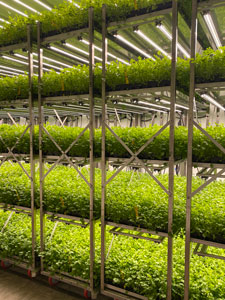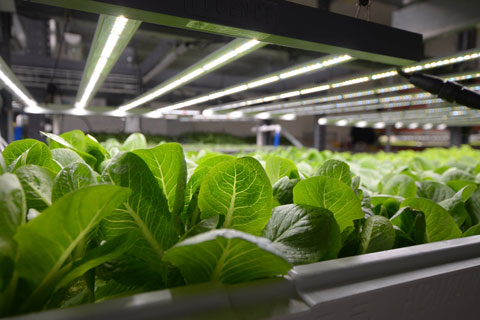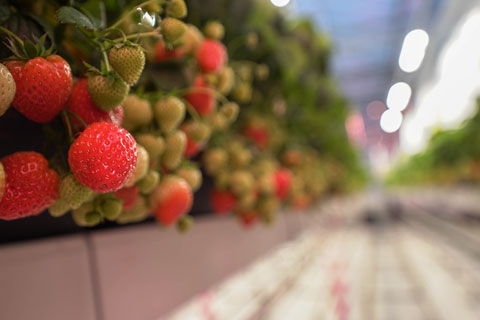5/1/2023
Finding Success Through the Little Things
Dr. Abhay Thosar

On the northwestern shore of Lake Erie, the city of Leamington is famously known as “The Tomato Capital of Canada,” both for growing and processing the high-value crop since 1908. For the past two decades, Leamington has maintained its status as the hub for commercial agriculture of high-wire crops—tomatoes, cucumbers and peppers—in the Great Lakes region.
Yet, recent challenges and changes have forced the greenhouse growers in Leamington to adapt and diversify. The foremost concern for tomato growers today is the advent and spread of the Tomato Brown Rugose Fruit Virus (ToBRFV), which is unaffected by the current resistance genes in tomatoes. ToBRFV has emerged as the most serious threat to global tomato production, and it’s not only changing the way tomato growers respond and act, but also how they plan for the future. Leamington provides a tremendous example of forward-thinking farming.
 Pictured: Healthy plants need strong roots and strong roots need a good growing medium. Key factors include—but are not limited to—the medium’s pH levels, electrical conductivity (EC), temperature, moisture and drainage.
Pictured: Healthy plants need strong roots and strong roots need a good growing medium. Key factors include—but are not limited to—the medium’s pH levels, electrical conductivity (EC), temperature, moisture and drainage.
Although known as “The Tomato Capital of Canada,” the greenhouses in Leamington have turned a new leaf, so to speak, by shifting their operations to grow other crops like strawberries, lettuce, leafy greens and herbs—at least until a more resistant tomato is engineered. But change isn’t always easy or straightforward.
For example, while both are red fruits, tomatoes and strawberries require quite disparate environmental conditions and inputs. Furthermore, growing strawberries in the field is very different from growing strawberries in a greenhouse, so growers are realizing the immediate challenges of cultivating new crops in a new setting with an altogether new market.
A similar scenario is playing out in many parts of the world today, as greenhouse growers are forced to adapt to fluctuations in market supply and consumer demand, rising energy costs, complex regulations and ever-emerging diseases—such as ToBRFV. Greenhouse operations and indoor farms are becoming increasingly more valuable as urban populations swell and climate change affects arable land. To meet consumer demand and maximize profitability, many growers are utilizing Fluence’s scientific research and horticulture expertise to optimize their facilities and procedures in the light of new crops and a changing landscape.
Solutions from science
Light is paramount for plants. Photosynthetic activity is—in no small way—related to light quality, spectrum and intensity. But there are many biological factors when growing in a greenhouse that affect plant growth, crop quality and—ultimately—the bottom line. Therefore, in addition to providing the highest quality LEDs, Fluence’s Horticultural Services Team proudly offers unparalleled support and science-backed solutions that target the specific kinds of challenges that growers are facing.
Fluence works directly with each grower to understand their specific objectives and to provide customized solutions. It’s vital for the growers to understand the fine-tuning that’s needed during the adaptation from growing under HPS to full LED solutions.
 Pictured: Fluence works with growers to adapt to new environmental and growing strategies to manage and overcome challenges such as electricity prices, emerging diseases or changing technologies.
Pictured: Fluence works with growers to adapt to new environmental and growing strategies to manage and overcome challenges such as electricity prices, emerging diseases or changing technologies.
A deep understanding of each operation’s specific objectives, geographic location and facility informs the entirety of the process. In other words, each growing operation is different, so the solution that works in one greenhouse for strawberries might need to be fine-tuned for another strawberry greenhouse grower. Of course, this fact holds true for every crop, which positions Fluence as a valuable resource for growers who are looking for the flexibility to adapt in a changing landscape. It’s important for growers everywhere to remember that there’s a global community of scientists, experts and plant enthusiasts (me included) who are ready to support them and their individual challenges.
Optimizing your operation
What factors should you be thinking about? These are some of the key considerations that should be addressed and adjusted based on each unique application:
Supplemental lighting: Understanding the regional DLI (Daily Light Integral) for each crop and making calculations for supplemental lighting should be based on the geographic location and objectives of the grower. Regional specific data is equally important when guiding our partners to success. Depending on the location of a greenhouse, we can determine the lighting requirements for any crop. The aggregate of natural lighting during the winter months is crucial when calculating the DLI for the crop grown under various spectrums of supplemental lighting. At Fluence, we offer complete solutions for the overall crop growth, looking at all the physiological factors that impact the crop’s response as driven by lighting.
 Pictured: Leamington, Ontario, Canada, growers have been branching out into new crops like strawberries, with some growing pains as they’ve learned the challenges of cultivating those crops.
Pictured: Leamington, Ontario, Canada, growers have been branching out into new crops like strawberries, with some growing pains as they’ve learned the challenges of cultivating those crops.
Environment: Fine-tuning the environmental conditions is first and foremost for growers to consider when retrofitting HPS with LEDs. Since LEDs don’t emit as much infrared when compared to HPS fixtures, the crop temperature will be lower when growing under LEDs. We understand the importance of plant temperature in relation to the physiological activities of the plant; this factor impacts the overall plant response and must be considered carefully. When adapting a new technology, it’s equally important for growers to adopt new thinking and working practices rather than to be stuck on the historical methods of growing.
Growing medium: Healthy plants need strong roots and strong roots need a good growing medium. Key factors include—but are not limited to—the medium’s pH levels, electrical conductivity (EC), temperature, moisture and drainage. These factors and more must be adjusted and fine-tuned to meet and match new lighting and growing strategies.
Humidity: Plants increase humidity in the air through the process of evapotranspiration. Water from the soil is absorbed by the roots then travels through the stems to the leaves, where it evaporates from pores on the leaves called stomata. While using LEDs, it’s important to manage the humidity compared to growing under HPS lighting. Each grower must consider the temperature set point, as well as the air movement while managing the humidity to ensure a good vapor pressure deficit (VPD) for the crop. These parameters go hand in hand with lighting management and infrastructure (energy curtains, vents, fans, etc.) within the greenhouse.
Day and night temperature: Maintaining a high temperature set point during the day and a low temperature set point at night is important for the different physiological processes in the plant—specifically the translocation of sugars. Depending on the supplemental light source, as well as the construction of the greenhouse, the grower will need to work on the set points for day/night, as well as the average temperature.
Irrigation: Managing your irrigation schedule under LEDs (compared to HPS) is an important adjustment. Generally, growers are under the impression that the crop will consume more water under LEDs, however, the opposite is true! Because LEDs emit less infrared light than HPS fixtures, growers will observe that plants reduce their water intake under LEDS, meaning they must adapt their irrigation schedule accordingly.
Nutritional management: The intersection of plant health and nutrition is an exciting area of study that brings together scientists from many fields. This area is even more relevant when targeting the improved photosynthetic activity of the plants with the use of correct spectrums and intensities from supplemental lights. Nutrition management is vital when trying to achieve specific quality objectives for certain crops. Because there’s less water uptake by the plants under LEDs, proper nutritional management is elevated with less room for error. Managing the electrical conductivity (EC) and availability of the nutrients is critical to achieve or maintain the quality of the produce.
Culture practice: When a grower begins to optimize the supplemental lighting source, environmental conditions, irrigation, nutrient management and more, the cultural practices for the crop will also need to be modified to respond to the other changes. For example, adjusting the plant density of the crop or even managing the crop (de-leafing, pruning, et al.) work differently under LEDs compared to HPS.
Dedicated to details
When competition is fierce, success is defined by details. It’s not just possible—but pertinent—to fine-tune every aspect of your environment and growing process. The Fluence Horticultural Services Team is here to help you dial in your greenhouse for complete optimization at every stage. Our dynamic solutions and support continue cycle after cycle so that you can meet the demands of a changing landscape and reap the rewards of Fluence LEDS year after year. After all, your success is our success.
Dr. Abhay Thosar is the Director of Horticulture Services with Fluence. Prior to joining Fluence, Abhay has worked as Senior Plant Specialist with Signify (Philips Lighting) for seven years, during which time he was responsible for developing plant recipes for high wire crops, leafy greens, herbs, strawberries and cannabis using horticulture LEDs, working closely with growers to optimize plant productivity through lighting and other environmental factors.